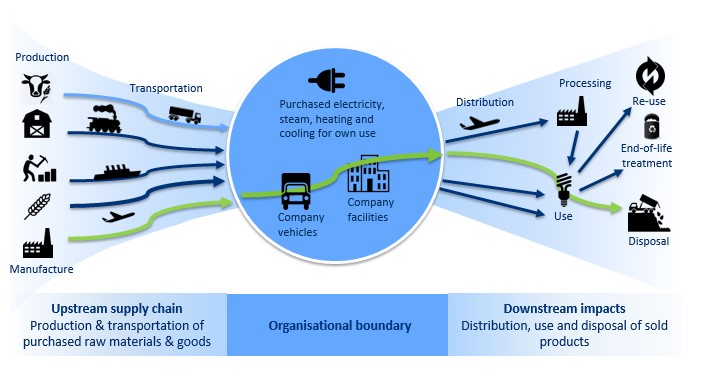Businesses which offer sustainable products and services stand out in the marketplace – so reduce your impact, boost your sales and achieve green growth by responding to this demand.
Introduction
Greening your product or service is the right thing to do to reduce your company’s environmental impact. It also makes perfect business sense – as well as providing an excellent marketing opportunity, it also helps to protect your business from future fluctuations in energy prices and resource costs.
In order to ‘green’ product or service, you’ll need to look beyond your organisation. Sometimes, the majority of the environmental impact from your product/service’s lifecycle are produced upstream or downstream from your own operations. For example, during the processing and transportation of raw materials, or whilst a product is being used (see diagram below for more examples). These impacts may affect your product or service prices or willingness to buy if energy prices rise. Whilst these emissions might be outside of your direct control, that doesn’t mean they should be ignored. Therefore, when considering how to reduce the environmental impact of your products or services, it is important to keep its whole lifecycle at the forefront of your approach.

Recommendations
- Materials
Reduce your raw materials where possible and look for more environmentally friendly options.
- Manufacturing
Where possible, change the manufacturing process to reduce energy and water use. Simplify the product packaging design to reduce the number and volume of materials. Cut out waste from production processes where you can.
- Retail
Redesign packaging where possible. Consider whether your products could be distributed in a more environmentally friendly way.
- Product in use
Consider the whole product life cycle. Could it be extended by making the product easier to repair? Could the life of any disposable parts be extended? Can the operating energy use be reduced by making it more energy efficient?
- Product end of life
- Reuse: Encourage the reuse of the product once its original use has expired.
- Recycle: Redesign the product and its packaging to maximise what can be recycled at the end of life.
- Disposal: Minimise packaging, especially if it can’t be recycled.

Additional Information
To give you an idea of what you are working towards, ‘Green’ products are likely to:
- be energy efficient and may have the potential to run on renewable energy such as solar PV;
- have lower levels of embodied carbon (i.e. they are made from materials which are less energy intensive to produce);
- have a positive environmental impact in comparison to other similar products, for example a low temperature detergent;
- be made from less hazardous materials; and
- be straightforward to recycle, or are themselves made from recycled materials.
For services, it is a little more abstract, but examples include:
- Green holidays, which use low-carbon travel and accommodation.
- Green events, which are held in energy efficient venues, produce little waste and serve low-carbon food.
- Green couriers, which use electric/ hybrid vehicles and cluster deliveries to save energy.
Engage your supply chain
In order to reduce the impact of your product or service, it may be easier to engage with your existing suppliers rather than trying to find more efficient suppliers. The first step, if you have many suppliers, is to identify the most carbon intensive of these. Discovering carbon emissions in a supplier’s footprint can help you to develop better relationships with them, as helping them identify and eliminate inefficiencies in their own processes will reduce their costs. This may also protect you against subsequent price increases from your suppliers.
Utility energy prices
Greening your product or service makes perfect business sense. Utility energy prices (gas and electricity) have been rising steadily over the last 10 years and inefficient, carbon intensive supply chains will become more costly due to regulation. Consequently, creating a more sustainable product/service that is less energy intensive to manufacture and deliver will protect you from future fluctuations in energy prices.
Publicise your achievements
Make your business, goods and services stand out from your competitors by exploiting the power of your sustainable business credentials. Consider how to make use of your achievements in your external communications and during the bidding processes. You can do this effectively by gaining an accreditation or a certification, for example the Carbon Trust offers product and service certification, to verify your achievement in reducing the product/service impact. There is also a supply chain certification which certifies your commitment and achievement to engaging your suppliers. There are many alternatives, so do your research or ask the START2ACT experts for advice.









